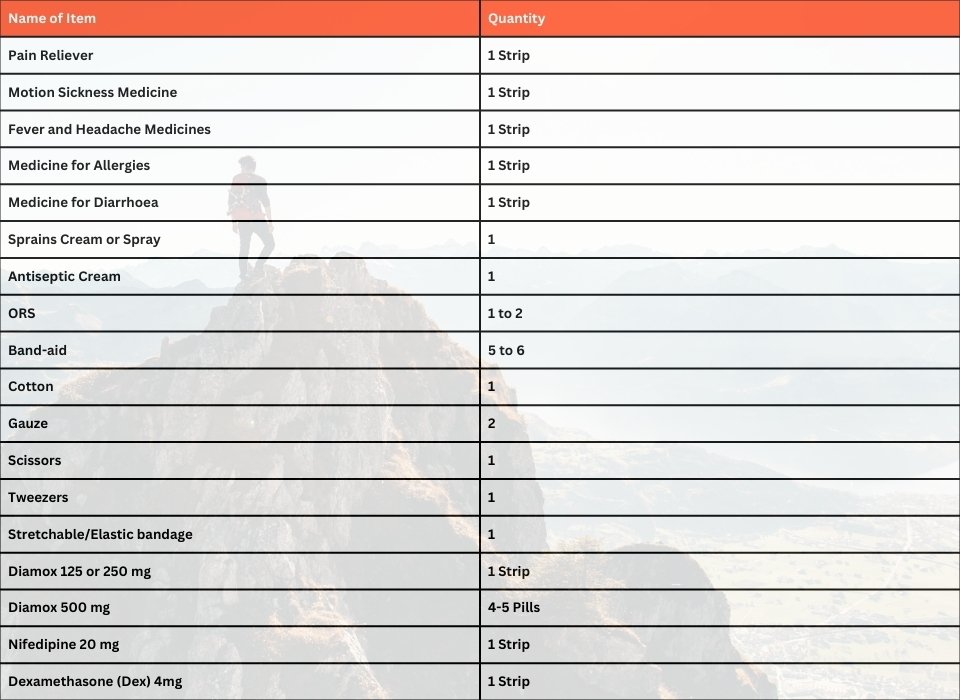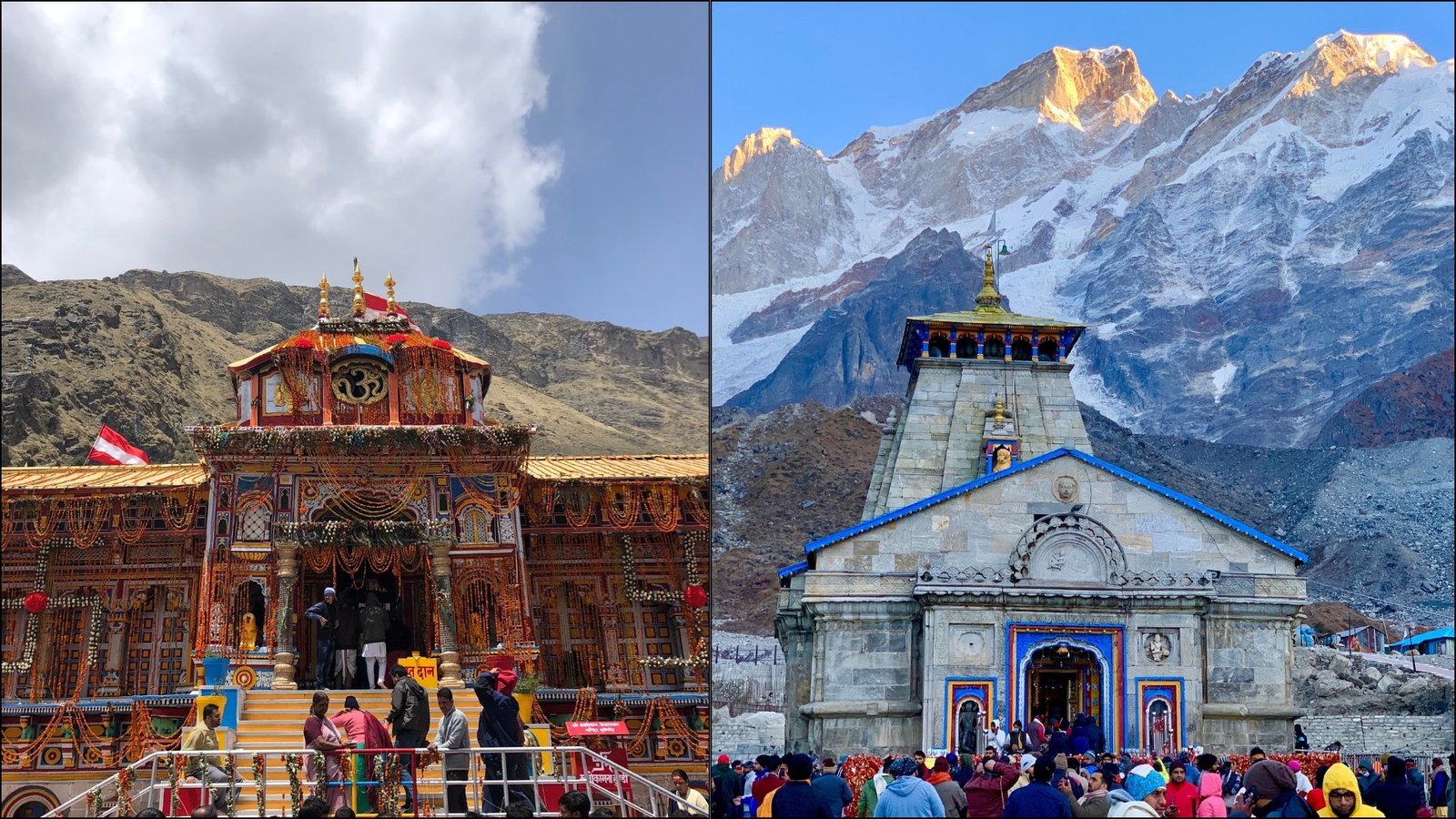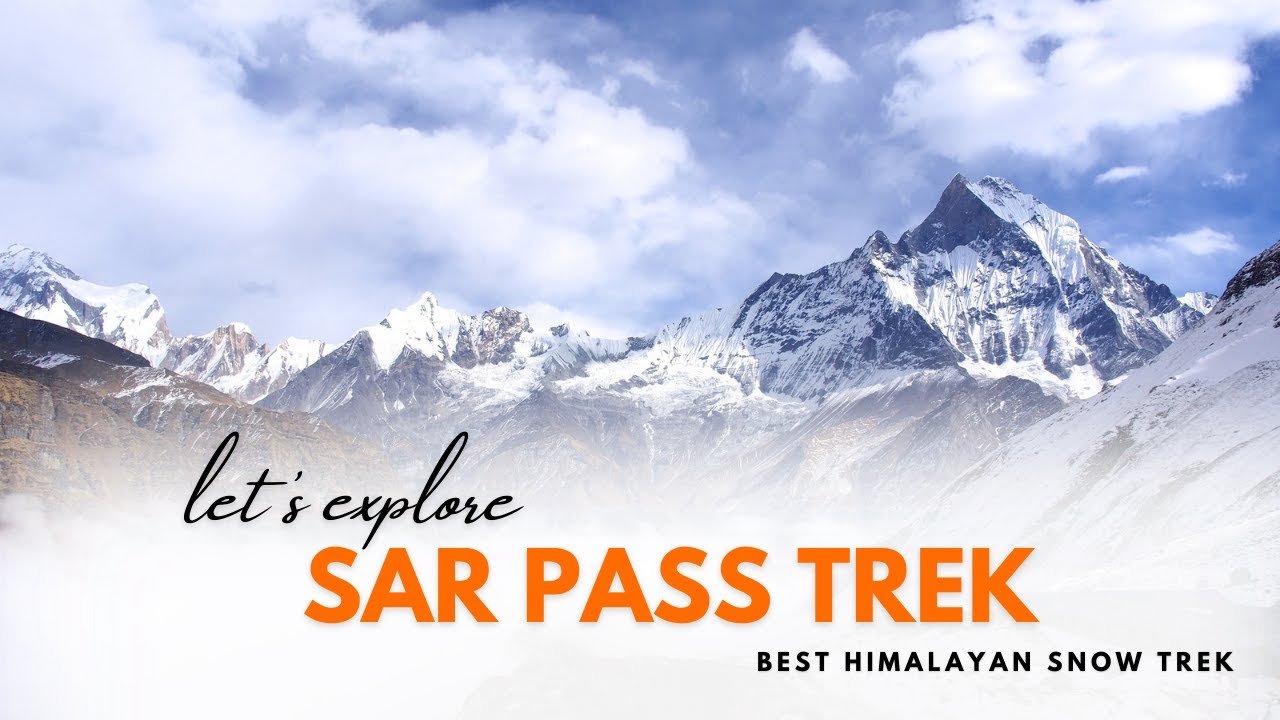Kedarnath Temple:
Located in the Garhwal Himalayan range, Kedarnath Temple is dedicated to Lord Shiva. It is one of the twelve Jyotirlingas and is believed to be built by the Pandavas. The temple is situated at an altitude of 3,583 meters (11,755 feet) above sea level, amidst stunning mountain landscapes. Devotees undertake a trek of approximately 16 kilometers from Gaurikund to reach the temple. However, there are also options for helicopter services for those who are unable to trek. The temple opens for a limited period each year due to extreme weather conditions in the region.Do Dham Yatra Guide
Day 01: Himalayan Hikers Team will pick up trekkers at Haridwar or Rishikesh at 6:30 AM. Then they will be taken to Sonprayag. Check in to respective hotels and rest for the night.
Day 02: Next day after breakfast, teams will be dispatched for the Kedarnath temple trail via Gaurikund. Jungle Chatti, Bheembali, and Linchauli are some of the camps you will pass during the trek. As the teams reach Kedarnath temple after covering the new trail, trekkers will stop to visit the temple and receive Lord Kedarnath’s blessings. Since teams will be staying overnight at camps, hikers will have a great opportunity to explore the surroundings. The tranquil grim of this place will leave trekkers yearning for more.
Day 03: After attending the morning ‘Aarti’, teams will prepare for their return. Trek from Kedarnath to Sonprayag on the same day.
Day 04: Travel from Sonprayag to Rudraprayag via Pandukeshwar and Badrinath. Overnight stay at Badrinath. En route from Guptkashi to Pandukeshwar, take a bath in the Kund. Then visit the abode of Lord Vishnu, “Badrinath.” You can also visit Vyas Gufa, Mana village, Mata Murti Temple, Charan Paduka, Bheem Kund, and the origin of the Saraswati River (Mukha).
Day 05: Explore Badrinath Dham and Mana, the last Indian village. Visit Vyas Gufa and Bhim Pul. Then return to Joshimath for an overnight stay.
Day 06: Drive from Joshimath to Rishikesh/Haridwar. Our services end here at around 6:00 PM.
Day 1:Haridwar/Rishikesh to Sonprayag, Night Stay in a Hotel
Total distance:(230 km) (6/7 Hours)
Mode of journey: By Tempo Traveller 13+D/ taxi, (Non-AC Vehicle)
Night stay:Hotel
Note: AC vehicles are only available for customized trek packages.Our teams will pick up trekkers at Haridwar or Rishikesh at 6:30 AM and then they will be taken to Sonprayag. Check-in to respective hotels and rest for the night.
The route from Haridwar or Rishikesh to Sonprayag offers mesmerizing views of the Himalayan landscapes and passes through scenic valleys, rivers, and small towns. Here’s a brief overview of the route:
Haridwar or Rishikesh to Sonprayag
The journey from Haridwar or Rishikesh to Sonprayag typically begins early in the morning around 6:30 AM.
The route initially follows National Highway 58 (NH 58), which runs along the Ganges River, offering beautiful views of the river and the surrounding hills.
As you proceed towards Sonprayag, you’ll pass through picturesque towns and villages nestled amidst the mountains.
The road gradually ascends as you enter the Garhwal Himalayas, and you’ll start witnessing stunning vistas of the snow-capped peaks.
En route, you may have brief stops at scenic viewpoints or roadside eateries to refresh and enjoy the views.
The journey usually takes around 8–10 hours, depending on road conditions and traffic.
Sonprayag Check-in
Upon reaching Sonprayag, trekkers will check into their respective hotels or accommodations.
Sonprayag serves as the base camp for the trek to Kedarnath, located around 5 kilometers from Gaurikund.
The village is situated at the confluence of the Mandakini and Basuki rivers, surrounded by lush greenery and towering peaks.
After check-in, trekkers can relax and unwind, enjoying the tranquility of the Himalayan surroundings.
Depending on the time of arrival, trekkers may explore nearby areas or take a leisurely stroll around Sonprayag to soak in the natural beauty.


Day 2:After breakfast Sonprayag to Kedarnath Temple
Total distance:16 km
Mode of journey: trek 16 Km
Night stay:Camp/Hotel
Route:
The trek from Sonprayag to Kedarnath Temple covers a distance of approximately 16 kilometers.
The trail follows a well-marked path that ascends gradually through the picturesque Mandakini Valley.
Trekkers start from Sonprayag and proceed towards Gaurikund, which serves as the base camp for the Kedarnath trek.
From Gaurikund, the trail continues along the Mandakini River, passing through lush forests, rocky terrain, and scenic meadows.
Along the way, trekkers will encounter various landmarks such as Rambara, where they can take a short break and refresh themselves.
The final stretch of the trek involves a steep ascent to reach Kedarnath Temple, situated at an altitude of approximately 3,583 meters (11,755 feet) above sea level.
Trek Level:
The trek from Sonprayag to Kedarnath Temple is considered moderately challenging.
While the distance is not excessively long, the altitude gain and terrain can make it physically demanding for some trekkers.
The trail includes both uphill and downhill sections, with some steep ascents and descents.
Trekkers should be prepared for varying weather conditions, including cold temperatures and occasional rainfall, especially during monsoon season.
It’s essential to maintain a steady pace, stay hydrated, and take regular breaks to avoid fatigue and altitude sickness.
Trekkers with a moderate level of fitness and prior trekking experience should be able to complete the trek comfortably with proper preparation and acclimatization.
Overnight Stay:
Upon reaching Kedarnath, trekkers can choose to stay overnight in camps or hotels available near the temple premises.
There are several accommodation options ranging from basic guesthouses to more comfortable hotels and tents.
Staying overnight allows trekkers to rest and rejuvenate before visiting the sacred Kedarnath Temple the next morning.
The accommodation facilities provide basic amenities such as bedding, meals, and hot water for bathing.
Trekkers can enjoy the tranquil surroundings and the awe-inspiring views of the Himalayas while staying overnight at Kedarnath.

Day 3: After attending the morning ‘Aarti’ teams will prepare for their return. Trek from Kedarnath to Sonprayag on the same day
Morning Aarti:
Start the day by attending the morning “Aarti” (ritual prayers) at the Kedarnath Temple.
The morning Aarti is a sacred ritual where devotees gather to offer prayers and seek blessings from Lord Shiva.
It’s a spiritually uplifting experience that sets a positive tone for the day ahead.
Trek from Kedarnath to Sonprayag:
After the morning Aarti, trekkers will begin their return journey from Kedarnath to Sonprayag.
The trek retraces the same route taken during the ascent, covering a distance of approximately 16 kilometers.
Trekkers will descend from Kedarnath Temple through the picturesque Mandakini Valley, passing by landmarks such as Rambara and Gaurikund.
The trail offers stunning views of the surrounding Himalayan peaks, including the majestic Kedarnath Peak.
Along the way, trekkers can take breaks, enjoy the natural beauty, and capture memorable moments.
It’s essential to pace oneself and descend carefully to avoid any injuries, especially on steep sections of the trail.
The descent usually takes around 6-7 hours, depending on individual walking speed and trail conditions.
Best Point near Kedarnath Temple for View:
One of the best points near Kedarnath Temple for a panoramic view of the surroundings is the Bhairav Temple.
The Bhairav Temple is located a short distance from Kedarnath Temple, offering stunning vistas of the Kedarnath Valley and surrounding peaks.
From here, trekkers can admire the beauty of the rugged terrain, the snow-capped mountains, and the flowing Mandakini River.
The Bhairav Temple itself holds significance in Hindu mythology and is dedicated to Lord Bhairav, a fierce manifestation of Lord Shiva.
Visitors can spend some time at the Bhairav Temple, soaking in the tranquility of the surroundings and capturing breathtaking views of the Himalayas.

Day 4: Drive from Sonprayag to Rudraprayag via Pandukeshwar and Badrinath overnight stay Badrinath Hotel
Drive from Sonprayag to Rudraprayag via Pandukeshwar and Badrinath
After completing the trek from Kedarnath to Sonprayag, trekkers will regroup and prepare for the next leg of the journey.
Teams will board vehicles for a scenic drive from Sonprayag to Rudraprayag.
The route passes through picturesque landscapes, winding mountain roads, and charming villages.
En route, trekkers will have the opportunity to visit Pandukeshwar, a small village known for its historical significance and ancient temple dedicated to Lord Yogadhyan Badri.
Pandukeshwar is believed to be the place where the Pandavas meditated after the Kurukshetra war.
Visitors can explore the temple complex, admire the architecture, and soak in the spiritual ambiance.
From Pandukeshwar, the journey continues towards Badrinath, one of the holiest Hindu pilgrimage sites.
Badrinath is home to the famous Badrinath Temple dedicated to Lord Vishnu, situated amidst the majestic Himalayas.
Upon reaching Badrinath, trekkers will check into their hotel accommodation and rest for the night.
Overnight stay in Badrinath offers the opportunity to relax, enjoy the serene surroundings, and prepare for the darshan (worship) at Badrinath Temple the next day.
Note: The drive from Sonprayag to Rudraprayag via Pandukeshwar and Badrinath offers breathtaking views of the Himalayan peaks, river valleys, and lush forests.
It’s advisable to start early in the day to make the most of the journey and ensure a comfortable arrival in Badrinath.
Additionally, trekkers should carry essentials such as water, snacks, and warm clothing for the drive, as the weather conditions in the mountainous region can vary.

Day 5: Explore Badrinath Dham and Mana the last village and Vyas Guffa and Bhimpool then back to Joshimath overnight stay Joshimath
Badrinath Dham:
Begin the day with a visit to the sacred Badrinath Temple, one of the Char Dham pilgrimage sites dedicated to Lord Vishnu.
Attend the morning puja (worship) and seek blessings from the deity.
Explore the temple complex, which features intricate architecture, sculptures, and religious artifacts.
Take time to soak in the spiritual ambiance and marvel at the breathtaking surroundings.
Mana Village:
After visiting Badrinath Temple, proceed to Mana Village, the last inhabited village near the India-China border.
Explore the village, known for its traditional wooden houses, local culture, and handicrafts.
Visit the Vyas Gufa (cave), believed to be the place where Sage Vyas composed the Mahabharata, one of the major Hindu epics.
Learn about the village’s history, customs, and daily life of its inhabitants.
Vyas Gufa and Bhimpul:
Explore Vyas Gufa, a natural cave associated with the sage Vyasa, who is said to have dictated the Mahabharata here.
Take a short trek to Bhimpul, a legendary bridge across the Saraswati River, believed to have been built by Bhima, one of the Pandava brothers.
Enjoy the serene surroundings and immerse yourself in the mythological stories associated with these sites.
Return to Joshimath:
After exploring Badrinath, Mana Village, Vyas Gufa, and Bhimpul, start your return journey to Joshimath.
The route from Badrinath to Joshimath offers stunning views of the Himalayan peaks, including Nanda Devi and Neelkanth.
Drive through picturesque landscapes, passing by lush valleys, gushing rivers, and charming mountain villages.
Upon reaching Joshimath, check into your hotel accommodation and unwind after a day of exploration.
Overnight stay in Joshimath allows you to rest and prepare for further travel or activities the next day.
Route:
The route from Badrinath to Mana Village and other sites involves driving along the Badrinath-Joshimath Road (NH 58).
Mana Village is located approximately 3 kilometers from Badrinath, and Vyas Gufa and Bhimpul are accessible by a short trek from the village.
The drive from Badrinath to Joshimath takes around 1.5 to 2 hours, covering a distance of approximately 45 kilometers.
The road passes through scenic terrain, offering breathtaking views of the mountains and valleys along the way.




Day 6: Driver from Joshimath to Rishikesh/Haridwar and Our service end here evening 6 pm.
Route:
Depart from Joshimath in the morning and begin the journey towards Rishikesh or Haridwar.
The route follows National Highway 58 (NH 58), which connects Joshimath to Rishikesh and Haridwar.
The road winds through the picturesque Garhwal region, offering stunning views of the Himalayan peaks, lush valleys, and gushing rivers.
As you descend from the higher altitudes of Joshimath towards Rishikesh/Haridwar, you’ll witness a change in landscape from alpine forests to subtropical vegetation.
Along the way, you may pass through charming mountain towns and villages, providing glimpses of local life and culture.
The drive typically takes around 8-10 hours, depending on road conditions, traffic, and weather.
Views:
Throughout the journey, you’ll be treated to breathtaking views of the Himalayan peaks, including Nanda Devi, Trishul, and Neelkanth.
The road offers panoramic vistas of the Alaknanda and Ganga rivers, which are considered sacred by Hindus.
You’ll pass by scenic spots such as Devprayag, the confluence of the Alaknanda and Bhagirathi rivers, where the Ganges River is formed.
The route also passes through lush forests, terraced fields, and cascading waterfalls, adding to the beauty of the landscape.
End of Service:
Arrive in Rishikesh or Haridwar by evening around 6 pm, where your service with the trekking company concludes.
Depending on your travel plans, you may choose to stay overnight in Rishikesh or Haridwar or continue your journey to other destinations.
Rishikesh and Haridwar offer a range of accommodation options, restaurants, and attractions for visitors to explore.
You can spend the evening relaxing by the Ganges River, attending the Ganga Aarti ceremony, or exploring the local markets before concluding your journey.

The best time to visit Kedarnath and Badrinath for the yatra is typically during the following periods:
Summer Season (May to June):
This is the most popular time for the yatra as the weather is relatively pleasant and the trekking routes are open.
The temperatures during this time range from mild to moderately cold, making it comfortable for trekking and temple visits.
However, this period also sees a high influx of pilgrims, so it’s advisable to plan and book accommodations in advance.
Autumn Season (September to October):
Another ideal time for the yatra is during the autumn season when the weather is cool and the skies are clear.
The temperatures are comfortable during the day, and the nights can be chilly.
This period also sees fewer crowds compared to the summer months, allowing for a more peaceful pilgrimage experience.
Pilgrimage Season (Opening and Closing Months):
The opening and closing months of the temples, generally in April/May and October/November respectively, are considered auspicious times for the yatra.
During these times, special ceremonies and rituals are performed at the temples, attracting a large number of devotees.
However, it’s essential to check the exact opening and closing dates of the temples each year as they may vary depending on weather conditions and other factors.
It’s important to note that the region experiences heavy snowfall and harsh weather conditions during the winter months (November to April), leading to the closure of the trekking routes and temples.
Therefore, it’s not advisable to undertake the yatra during this time unless you’re well-prepared for extreme weather conditions and have arranged for helicopter services to reach the temples.
The yatra level can be considered moderate to challenging due to the altitude and the terrain of the Himalayan region.
The trek to Kedarnath Temple involves a moderate to strenuous trek of approximately 16 kilometers from Gaurikund, which is the base camp.
The trekking path to Kedarnath includes steep inclines and rough terrain, which may be challenging for some pilgrims.
However, there are options for hiring mules or palanquins for those who may find the trek difficult.
Similarly, the journey to Badrinath Temple can also be challenging due to the altitude and the winding mountain roads.
However, most of the journey to Badrinath can be done via road, making it accessible to a wider range of pilgrims.
Both Kedarnath and Badrinath are situated in high-altitude regions, so it’s important for pilgrims to acclimatize themselves to prevent altitude sickness.
Pilgrims are advised to undertake the journey with proper preparation, including appropriate clothing, footwear, and necessary medical supplies.
Haridwar and Rishikesh are two common starting points for the Do Dham Yatra to Kedarnath and Badrinath, both of which are well-connected by road, rail, and air. Here’s how you can reach Haridwar or Rishikesh:
By Train: Haridwar is well-connected to Delhi by train, and there are several trains that operate between the two cities. Some of the popular trains include the Shatabdi Express, Jan Shatabdi Express, and the Haridwar Mail. The journey takes around 4 to 5 hours, depending on the train and the route.
By Bus: There are regular bus services from Delhi to Haridwar, operated by both government and private operators. The journey takes around 6 to 7 hours, depending on the traffic and the route.
By Car: Haridwar is around 220 km from Delhi, and it takes around 5 to 6 hours to reach Haridwar by car. You can either hire a taxi or drive your own vehicle.
By Air: The nearest airport to Haridwar is the Jolly Grant Airport in Dehradun, which is around 35 km from Haridwar. From the airport, you can take a taxi or a bus to reach Haridwar.
Overall, the most convenient and comfortable way to reach Haridwar from Delhi is by train. However, depending on your budget and preferences, you can choose any of the other options as well.

Mandatory Documents
Original and photocopy of government photo identity card- (Aadhar Card, Driving License, Voters ID, etc,)
Passport and Visa important to foreigners
Medical Certificate (First part should be filled by the Doctor and Second part by the Trekker)
Declaration Certificates
Note: – Many trekkers commit the same mistake of carrying unnecessary items on a trek which only makes the backpack heavy. It is important to know the right items to carry. It differs from season to season if you are trekking in summers then carry less layers of warm clothing and if you are trekking in winters carry enough layers to protect yourself against chilly cold.
Necessary Items for trekkers

Basic Trekking Gears

The Clothes You Should Bring On On Do Dham Yatra

Head Gears

Foot Gears

Personal Care Essentials

Carry a Personal Medical Kit


Are you Looking for Trekking Equipment on Rent?
If any trekker requires trekking equipment on rent, Himalayan Hikers offers the best-quality gear available for rental. Many individuals are in need of such equipment, and renting provides a cost-effective solution, allowing them to access high-quality gear at an affordable price without the need for a significant investment for short-term use.

Trek Equipment You can book directly on first day at the Sankri Base Camp.
Note:-
Please take all medicines only when prescribed by the doctor. In case you face any problem during your trek,
discuss and take advice from the Professional guide.
Himalayan Hikers is a reputable trekking company that places a high priority on safety. Here are some of the safety measures they take to ensure the safety of their clients during the Yatra:
Experienced Guides: Himalayan Hikers hires experienced and certified guides who are well-versed in the terrain, weather conditions, and local culture. These guides have first-hand knowledge of the routes and are equipped to handle any emergency situations that may arise.
Proper Gear: The company provides all the necessary gear and equipment to their clients to ensure comfort and safety during the trek.
Hygiene and Sanitation: Himalayan Hikers places great emphasis on hygiene and sanitation during the Yatra. They provide clean drinking water, hand sanitizers, and toilet tents to ensure that their clients are healthy and comfortable.
Emergency Services: The company has a well-defined protocol for handling emergency situations. They have a team of trained medical professionals who are available 24/7 and can be quickly mobilized in case of an emergency.
Acclimatization: Himalayan Hikers follows a gradual acclimatization process during treks to ensure that their clients adjust to the high altitude gradually. They also monitor the health of their clients regularly and provide necessary medical attention if required.
Overall, Himalayan Hikers places a great emphasis on safety and takes all necessary measures to ensure the safety and well-being of their clients during treks.






